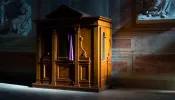The Rosary is a centuries-old way of praying. "Medieval piety in the West developed the prayer of the Rosary as a popular substitute for the Liturgy of the Hours." Although obviously Marian in character, it is Christ-centered in its essentials. It is a meditation on the lives of both our Lord and the Virgin Mary. "Christian prayer tries above all to meditate on the mysteries of Christ, as in ... the Rosary."
"Meditation engages thought, imagination, emotion, and desire. This mobilization of faculties is necessary in order to deepen our convictions of faith, prompt the conversion of our heart, and strengthen our will to follow Christ."
Meditation upon these mysteries leads us to contemplation: "This form of prayerful reflection is of great value, but Christian prayer should go further: to the knowledge of the love of the Lord Jesus, to union with him."2
The Rosary has a structure and method designed to help us more readily assimilate the mysteries into our spiritual life. Structurally, it is divided into four parts; each part, into five mysteries. For each mystery is said one "decade" consisting of one Our Father, ten Hail Marys and one Glory Be.
Though at first sight this method of repetition may seem to be tedious and boring, it is better understood when considered as an act of love: "when the Rosary is thought of as an outpouring of that love which tirelessly returns to the person loved with expressions similar in their content but ever fresh in terms of the feeling pervading them."3
It is also important to remember that though these repeated invocations are directed to Mary, our acts of love are ultimately directed to Jesus himself, through her intercession. In many Catholic families, there is a pious custom of reciting daily one part of the Rosary.
Structure of the Rosary
Make the Sign of the cross:
In the name of the Father, and of the Son, and of the Holy Spirit. Amen.
There are, at present, many legitimate ways of introducing the Rosary, in different parts of the Church and following different customs. They should all appropriately prepare the mind for contemplation. The beginning of Psalm 70 is frequently used: "O God, come to my aid; O Lord, make haste to help me." Also common is the recitation of the Apostles' Creed:
I believe in God, the Father almighty,
creator of heaven and earth.
I believe in Jesus Christ, his only Son, our Lord.
He was conceived by the power
of the Holy Spirit
and born of the Virgin Mary.
He suffered under Pontius Pilate,
was crucified, died, and was buried.
He descended into hell.
On the third day he rose again.
He ascended into heaven,
and is seated at the right hand of the Father.
He will come again to judge
the living and the dead.
I believe in the Holy Spirit,
the holy Catholic Church,
the communion of saints,
the forgiveness of sins,
the resurrection of the body,
and life everlasting. Amen.
Then, for an increase in the virtues of faith, hope, and charity
Our Father. Three Hail Marys. Glory Be.
Now, begin the mysteries of the day. Start each decade by announcing the mystery and directing your imagination and attention towards that particular episode in the life of Christ or our Lady.
It can be useful to follow the announcement of the mystery with the reading of a related scriptural passage, as indicated below. In this way, the Rosary is not merely a matter of recalling information but of allowing God to speak to you directly through his word.
Ideally, this should be followed by a period of silence, in which to reflect upon the scripture passage before moving on to vocal prayer.
Then proceed to the recitation of the decade. On the large bead say the Our Father. On each of the ten small beads, say a Hail Mary. Then pray the Glory Be.
Each decade is a contemplation of the life of our Lord, witnessed by Mary-one aspect of the paschal mystery. In recognition of the connection with Christian life, one should conclude one's contemplation of each of them with a prayer for the fruits specific to that particular mystery. Alternatively, a more general prayer may be said, according to custom, such as the following:
O my Jesus, forgive us our sins, save us from the fire of hell, draw all souls to heaven, especially those who are in most need of your mercy.
or:
Mary, mother of grace, mother of mercy, shield me from the enemy and receive me at the hour of my death. Amen.
At the end of the Rosary any suitable prayers may be said, though the following are the most common: the Hail Holy Queen (p. 470-471) followed by the prayer O God, whose only-begotten Son, . . . (p. 441); or the Sub tuum Præsidium (We Fly to Your Patronage) followed by and the Litany of the Blessed Virgin Mary (p. 437).
Meditations on the Mysteries of the Rosary
"The Rosary is one of the traditional paths of Christian prayer directed to the contemplation of Christ's face ... "
"After the announcement of the mystery and the proclamation of the word, it is fitting to pause and focus one's attention for a suitable period of time on the mystery concerned, before moving into vocal prayer. A discovery of the importance of silence is one of the secrets of practicing contemplation and meditation. One drawback of a society dominated by technology and the mass media is the fact that silence becomes increasingly difficult to achieve. Just as moments of silence are recommended in the Liturgy, so too in the recitation of the Rosary it is fitting to pause briefly after listening to the word of God, while the mind focuses on the content of a particular mystery (John Paul II. Apostolic Letter Rosarium Virginis Mariæ, October 16, 2002. nos. 18, 31)."
The meditations that follow are from Holy Rosary, written in 1931 by St. Josemaría Escrivá. A meditation on the Luminous Mysteries did not appear in Holy Rosary, but throughout his life St. Josemaría lovingly contemplated and preached on these scenes, just as he did with every chapter of the Gospels. Therefore we have included here some excerpts from among his writings that make reference to the Luminous Mysteries, to help readers meditate on the complete Rosary.
The Mysteries of The Rosary
Joyful
Mondays and Saturdays
-
The Annunciation
(Lk 1: 26-38) -
The Visitation
(Lk 1: 39-56) -
The Nativity
(Lk 2: 1-20) -
The Presentation
(Lk 2: 22-38) -
The Finding of Jesus in the Temple
(Lk 2: 41-52)
Luminous
Thursdays
-
The Baptism of Christ in the Jordan
(Mt 3: 13-17 / Mk 1: 4-11) -
The Manifestation of Christ at the wedding of Cana
(Jn 2: 1-11) -
The Proclamation of the Kingdom of God, with his call to conversion
(Mt 4: 12-25 / Mk 1: 15 & 2: 3-13 / Lk 7: 47-48 / Jn 20: 22-23) -
The Transfiguration
(Mt 17: 1-9 / Lk 9: 28-36) -
The Institution of the Eucharist
(Lk 22: 14-20 / Jn 13: 1)
Sorrowful
Tuesday and Friday
-
The Agony in the Garden
(Mt 26: 36-56) -
The Scourging at the Pillar
(Is 53: 1-12 / Mk 15: 1-15) -
The Crowning with Thorns
(Mk 15: 16-20 / Mt 27: 27-31) -
The Carrying of the Cross
(Lk 23 : 26-32 / Mk 10: 17-21) -
The Crucifixion
(Jn 19: 17-30 / Mt 27: 35-56)
Glorious
Wednesdays and Sundays
-
The Resurrection
(Mt 28: 1-15 / Lk 24: 1-49 / Mk 16: 1-18) -
The Ascension
(Acts 1: 3-11) -
The Descent of the Holy Spirit
(Acts 2: 1-21) -
The Assumption
(Rev 12: 1) -
The Coronation of the Blessed Virgin Mary
(Lk 1: 46-55)











